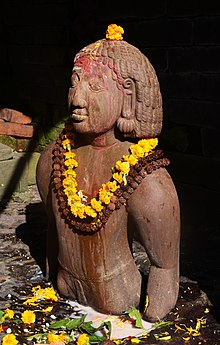Kirat Mundhum
This article needs additional citations for verification. (January 2023) |
Ancestor worship •Satyahangma tradition of Mahaguru Phalgunanda |
Kirat Mundum, (

Religious texts
It has the religious
The religious texts for each tribe consists of customs, habits, rituals, traditions, and myths passed down from the Kirati tribe's ancestors. Religious texts serve, in a way, as customary laws which guide Kirats in their daily lives.[18] Their religious texts also distinguishes each Kiranti tribe from other Kirati and non-Kiratis as well.[18]
Practices
Kirants practice
Festivals

All four Kirants celebrate some similar and different festivals throughout the year. Some common festivals are Udhauli, Ubhauli and New year Yele Sambat (Maghe Sankranti).
Newars Celebrate Yenna, and Indrajatra and other festivals of the Valley, relationg to Yalamaber, Yela, Khopa, Ye.
In both Ubhauli and Udhauli, they sacrifice a rooster and offer ginger, rice, homemade alcohol, and tree resin (resin is put in the burning coal for fragrance) as worship, they also conduct a Sakela dance. In this dance, they perform all of their daily life activities such as planting rice, harvesting etc. During the dance the will also copy the behavior of animals and birds which are part of their day-to-day life. The Limbu Kirant celebrates Udhauli Chasok Tangnam on the day of Mangshir Purnima and Ubhauli (Yokwa Tongnam) in the month of Baisakh. Other Kirants (Yakkha and Sunuwars) also celebrate in their own way.
Sakela Sili is observed twice a year in the month of Baisakh Purnima and Mangsir Purnima, namely Ubhauli (going up) and Udhauli (coming down), indicating the migration pattern of the birds named Karyangkurung respectively. A Nakchhong performs the sacrificial offering, chula puja and other rituals in the Sakela Than. The dance is then led by a Silimappa and Silimamma and the Kirat community people come together in their traditional attire to form a circle and sing and dance together to the beats and rhythms of drums (Dhol) and cymbals (Jhyamta) enacting their daily life activities as well as mimicking different animals and birds. The sili or the dance moves reflect different aspects of human life and their relationship with nature.
Kiratis worship nature; therefore, Sakela Puja also known as Bhumi Puja is a prayer to Mother Nature. During Ubhauli, Kiratis worship Mother Nature for good crops and protection from natural calamities during the time of cultivation and farming. Likewise, Kiratis offer their gratitude and thanks to Mother Nature during Udhauli (harvesting time) for bestowing them with good crops. [19]
See also
- Folk Hinduism
- Hindu denominations
- Religion in Nepal
- Tribal religions in India
- Bon religion
- Buddhism in Nepal
- Hinduism in Nepal
- Demographics of Nepal
- Limbu language
- Bantawa language
- Chamling language
- Rai languages
- Te-ongsi Sirijunga Xin Thebe
- Mundhum
References
- ^ "Census Nepal caste-ethnicity results 2021".
- ^ "final layout pdf.p65" (PDF). Archived from the original (PDF) on 2009-09-02. Retrieved 2008-01-22.
- ^ p. 56 Kiratese at a Glance By Gopal Man Tandukar
- ^ p. xxv A Grammar of Limbu By Geordefine sungge van Driem
- ^ Problems of Modern Indian Literature by Statistical Pub. Society: distributor, K. P. Bagchi
- ^ p. 323 Kiratas in Ancient India By G. P. Singh, Dhaneswar Kalita, V Sudarsen, M A Kalam
- ^ "History and Culture of the Kirat" by I.S.Chemjong
- ^ p. 535 Nepal By Tom Woodhatch
- ^ "Archived copy" (PDF). Archived from the original (PDF) on 2013-04-18. Retrieved 2012-11-01.
{{cite web}}: CS1 maint: archived copy as title (link) - ^ Schools as Zones of Peace in Nepal By Isabelle Duquesne LIT Verlag Münster, 12 Jan 2016
- ^ Page 45 Contemporary Society: Concept of tribal society By S. N. Ratha, Georg Pfeffer, Deepak Kumar Behera, 1997
- ^ P.6 European Bulletin of Himalayan Research, Issues 17-19 By Südasien Institut, 1999
- ISBN 978-1-85973-150-5.
- ISBN 81-250-0188-3.
- ISBN 99933-809-1-1.
- ^ "Cultures & people of Darjeeling". Archived from the original on 2013-10-04. Retrieved 2008-04-11.
- OCLC 57068666. Archived from the original(PDF) on 2009-09-02. Retrieved 2008-01-22.
- ^ a b p. 65 Culture, Creation, and Procreation By Monika Böck, Aparna Rao
- ^ p. 108 Politics of Culture: A study of three Kirata communities in the Eastern Himalayas by T.B. Subba
